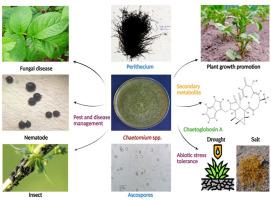毛菌:一种用于作物病害可持续管理的多方面真菌生物防治剂
IF 3.3
3区 农林科学
Q2 PLANT SCIENCES
引用次数: 0
摘要
近年来,消费者越来越担心化学杀菌剂对人类健康和环境的不利影响。因此,全球研究人员对探索保护作物的替代方法产生了浓厚的兴趣。毛藻已成为植物病害特别是真菌、线虫和昆虫病害的有效生物防治剂,为化学杀菌剂提供了可持续和环保的替代品。然而,重要的是要认识到一些天然物质,包括生物防治剂产生的某些代谢物,也可能含有有毒化合物,对非目标生物构成危险。本文综述了毛藻在促进植物生长、诱导系统抗性和抑制植物病害等方面的作用,并对其生物活性代谢物的安全性进行了评价。重点讨论了毛藻的多样性及其与植物的相互作用。分子表征技术的进步使毛藻种类的分化和鉴定成为可能,每种毛藻都具有独特的生物防治特性。毛藻的生物合成基因簇负责产生一系列具有生物活性的次生代谢物。毛藻采用各种生物防治策略,如抗生素、竞争和支寄生虫来对抗竞争病原体的存在,有效地阻碍了它们的生长。这些机制需要产生特定的代谢物,如抗生素,通过防御相关酶和细胞壁降解酶诱导抗病性,以阻碍植物中竞争病原体的发展。毛藻被广泛认为是一种多功能和有效的生物防治剂,可以对抗多种植物病原体。本文章由计算机程序翻译,如有差异,请以英文原文为准。

Chaetomium spp.: A multifaceted fungal biocontrol agent for sustainable management of crop diseases
In recent years, consumers have grown increasingly apprehensive about the adverse effects of chemical fungicides on both human health and the environment. Consequently, there has been a surge of interest among researchers globally in exploring alternative methods to safeguard crops. Chaetomium species have emerged as effective biological control agents (BCAs) for the management of plant diseases specifically fungus, nematode and insect, providing sustainable and eco-friendly alternatives to chemical fungicides. However, it is important to recognize that some natural substances, including certain metabolites produced by biocontrol agents, may also contain toxic compounds that pose risks to non-target organisms. This review scrutinizes the multifaceted role of Chaetomium spp. in promoting plant growth, inducing systemic resistance and suppressing plant diseases, while also addressing the need to assess the safety of their bioactive metabolites. It discusses the diversity of Chaetomium spp and interaction with plants focusing on physiological mechanisms. Advances in molecular characterization techniques have enabled the differentiation and identification of diverse Chaetomium species, each possessing unique biocontrol attributes. Biosynthetic gene cluster of Chaetomium spp. are responsible for producing a wide array of secondary metabolites with bioactive properties. Chaetomium employ various biocontrol strategies such as antibiosis, competition and mycoparasitism to counteract the presence of competing pathogens, effectively hindering their growth. These mechanisms entail the production of specific metabolites such as antibiosis, induction of disease resistance through defense related enzymes and cell wall degrading enzymes to hinder the development of rival pathogens in plants. Chaetomium spp. are widely recognized as versatile and effective biocontrol agents against a broad spectrum of plant pathogens.
求助全文
通过发布文献求助,成功后即可免费获取论文全文。
去求助
来源期刊
CiteScore
4.30
自引率
7.40%
发文量
130
审稿时长
38 days
期刊介绍:
Physiological and Molecular Plant Pathology provides an International forum for original research papers, reviews, and commentaries on all aspects of the molecular biology, biochemistry, physiology, histology and cytology, genetics and evolution of plant-microbe interactions.
Papers on all kinds of infective pathogen, including viruses, prokaryotes, fungi, and nematodes, as well as mutualistic organisms such as Rhizobium and mycorrhyzal fungi, are acceptable as long as they have a bearing on the interaction between pathogen and plant.

 求助内容:
求助内容: 应助结果提醒方式:
应助结果提醒方式:


